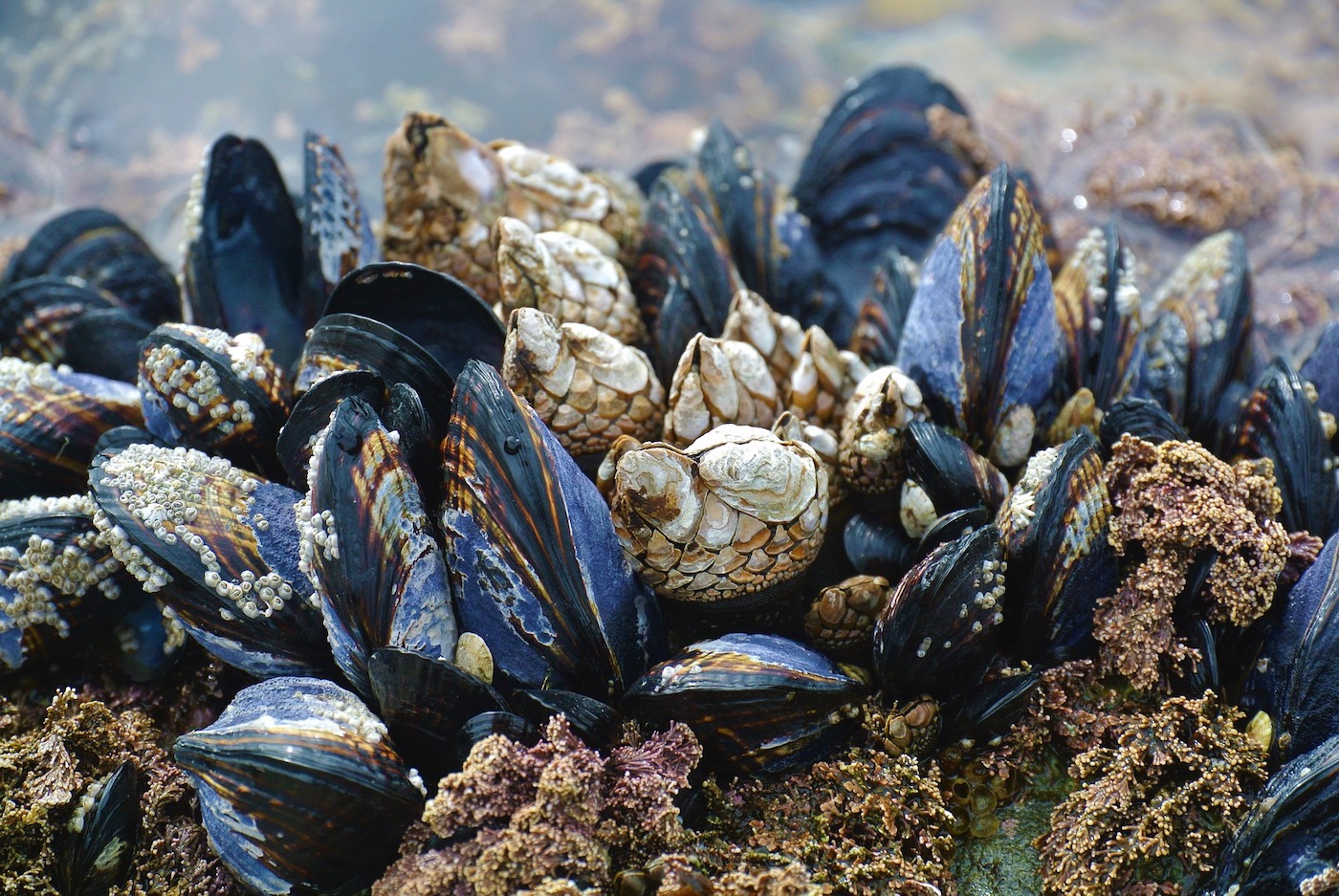 Maths, Physics & Chemistry
Maths, Physics & Chemistry
Mussel powder engineered to kill pathogens
We re-engineered the adhesive used by mussels to stick to surfaces like ship hull, rocks, and piers to create a powder that can kill pathogens. When hydrated, the powder generates a common disinfectant, hydrogen peroxide, and effectively kills two types of bacteria and two types of viruses.

Hydrogen peroxide is a commonly used disinfectant. A typical household may have a bottle of 3% hydrogen peroxide solution for disinfecting minor cuts and scrapes. Concentrated hydrogen peroxide is also used in municipal wastewater and drinking water treatments, in petrochemical refinery applications, and in bleaching of paper products. However, concentrated hydrogen peroxide is explosive and very dangerous to store and transport. A dilute solution of hydrogen peroxide is safe but very bulky and not very portable. Our research group developed a powder that can generate hydrogen peroxide when the powder is hydrated in water. This technology is based on the unique chemistry found in mussel adhesive proteins.
Marine mussels secrete adhesive proteins that enable these organisms to bind to various surfaces underwater (ship hulls, rocks, piers, etc.). One of the key ingredients in these adhesive proteins is a compound called catechol. Many research labs around the world have utilized catechol to create tissue adhesives and wound dressings so that they can stick better to wet tissue surfaces. One interesting phenomenon about catechol is that under certain conditions, it generates hydrogen peroxide as a byproduct. In this study, we wanted to use this particular ability of catechol to create a powder that can release hydrogen peroxide for disinfecting various pathogens, such as bacteria and viruses.
Our research group created micron-sized powder-like particles that contain catechol. These particles are solidified in an emulsion (like tiny bubbles in soapy water) and adopt the spherical shape and size of these tiny bubbles. To generate hydrogen peroxide, the particles are hydrated in a neutral or slightly basic solution (blood, seawater or solutions containing baking soda are slightly basic). The oxygen in the solution oxidizes the catechol to generate hydrogen peroxide as the byproduct. Because these particles are so small, they have a large surface area and can release the hydrogen peroxide very quickly. These particles can continue to generate hydrogen peroxide for over four days. These particles can be deactivated when placed in an acidic solution (similarly to an orange juice) and reactivated in a slightly basic solution.
These particles were used to disinfect two types of bacteria and two types of viruses. The bacteria strains were Staphylococcus epidermidis (S. epidermidis) and Escherichia coli (E. coli). S. epidermidis is commonly found on the skin and is responsible for hospital-acquired infections. On the other hand, E. coli is commonly associated with food poisoning. These bacteria strains were completely killed within six to twenty four hours. Our particles also reduced the infectivity of an enveloped virus (bovine viral diarrhea virus) and a non-enveloped virus (porcine parvovirus) by more than 99.9% within 12 hours. These are standard viruses used by the United States Food and Drug Administration (FDA) to test virus removal operations while developing new vaccines.
In conclusion, catechol was incorporated into micron-sized particles. These powder-like particles generated hydrogen peroxide when they were hydrated in a slightly basic aqueous solution. The powder does not contain hydrogen peroxide and converts oxygen found within the aqueous solution into hydrogen peroxide. The released hydrogen peroxide effectively disinfected two types of bacteria and two types of viruses.
This technology takes advantage of the unique chemistry found in mussel adhesive proteins to create a novel powder-based disinfectant. This powder is lightweight and portable when compared to the large volume of diluted hydrogen peroxide solution found typically in a household. This powder has many potential applications. It could potentially be used as a portable disinfectant for open wounds, to prevent bacterial and viral infections (rabies, tick-borne viruses, etc.). It could also be used for disinfecting hospitals or surgery suites in underdeveloped countries.
Original Article:
H. Meng et al., Biomimetic recyclable microgels for on-demand generation of hydrogen peroxide and antipathogenic application. Acta Biomater 83, 109-118 (2019)Next read: Blocking protein folding to fight antibiotic resistance by R. Christopher D. Furniss , Nikol Kaderabkova , Despoina A.I. Mavridou
Edited by:
Massimo Caine , Founder and Director
We thought you might like
Insect microbiomes – a new hope against antimicrobial resistance?
Aug 2, 2019 in Microbiology | 3.5 min read by Fabio PalmieriThe antibacterial life of abandoned mines
Sep 9, 2019 in Microbiology | 3.5 min read by Gerusa Senhorinho , John Ashley ScottReinventing a bacterial biopesticide: an old microbe with a fresh new look
Sep 24, 2019 in Microbiology | 3.5 min read by Alex J. MullinsMore from Maths, Physics & Chemistry
Natural products might just be our best weapon against antibiotic resistance
Apr 3, 2024 in Maths, Physics & Chemistry | 3.5 min read by Olivier Kirchhoffer , Jahn Nitschke , Jean-Luc WolfenderHeading underground with cold atoms
Dec 1, 2023 in Maths, Physics & Chemistry | 3 min read by Jamie Vovrosh , Sam Hedges , Farzad HayatiHolographic sound fields shape 3D matter without a touch
Nov 15, 2023 in Maths, Physics & Chemistry | 4 min read by Kai MeldeHow to make a kilonova: Finding a path for cosmic alchemy
Oct 25, 2023 in Maths, Physics & Chemistry | 3.5 min read by Noel Richardson , Clarissa PavaoSurfing the Waves of Quantum Matter in Warm Classical Seas
Oct 23, 2023 in Maths, Physics & Chemistry | 4 min read by Imran Saeed , Tsvi Tulsty , Hyuk Kyu PakEditor's picks
Trending now
Popular topics


